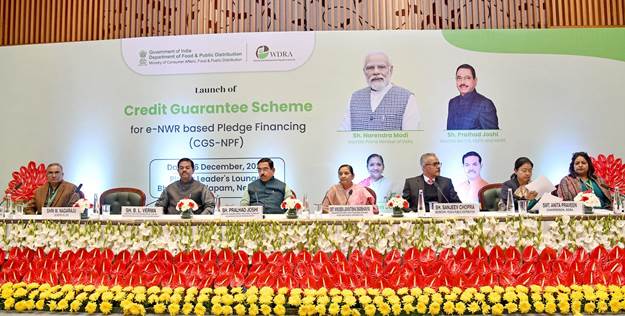Credit Guarantee Scheme for e-NWR based Pledge Financing (CGS-NPF)

- 17 Dec 2024
In News:
The Credit Guarantee Scheme for e-NWR based Pledge Financing (CGS-NPF), launched by Union Minister Pralhad Joshi aims to support farmers by facilitating post-harvest finance using electronic negotiable warehouse receipts (e-NWRs). This initiative is part of the government’s efforts to minimize distress selling and ensure financial security for farmers, particularly small and marginalized ones.
Key Features of the Scheme:
- Total Corpus: ?1,000 crore for post-harvest finance.
- Loan Coverage:
- Agricultural purposes: Loans up to ?75 lakh.
- Non-agricultural purposes: Loans up to ?200 lakh.
- Eligible Borrowers: Small and marginal farmers, women, SC/ST/PwD farmers, MSMEs, traders, Farmer Producer Organizations (FPOs), and farmer cooperatives.
- Eligible Institutions: All scheduled and cooperative banks.
- Guarantee Coverage:
- Small and marginal farmers/Women/SC/ST/PwD: 85% for loans up to ?3 lakh, and 80% for loans between ?3 lakh to ?75 lakh.
- Other borrowers: 75% coverage for loans up to ?200 lakh.
- Risks Covered: Both credit risk and warehouseman risk.
- Guarantee Fees: 0.4% per annum for farmers, and 1% per annum for non-farmers.
Objectives:
- Minimize distress selling: By providing easy access to loans post-harvest, the scheme helps farmers avoid selling produce at low prices due to cash crunches.
- Instill confidence in banks: The scheme provides a guarantee cover to lenders, encouraging them to offer loans against e-NWRs.
- Encourage warehouse registration: The scheme emphasizes the need for more warehouses, particularly those closer to farmland, to improve accessibility for farmers.
About e-NWRs:
- e-NWRs are digital versions of traditional warehouse receipts that enable farmers to pledge stored commodities as collateral for loans.
- These receipts are governed by the Warehousing (Development and Regulation) Act of 2007, and since 2017, e-NWRs have been mandated for use in transactions related to agricultural produce stored in WDRA-accredited warehouses.
Expected Impact:
- This scheme is expected to boost post-harvest lending, with a target of increasing lending to ?5.5 lakh crore in the next decade.
- It will improve farmers’ income, reduce dependence on informal credit sources, and foster better financial inclusion.
- Additionally, it will create a more reliable supply chain for agricultural produce, enhancing food security.
Future Targets:
- Increase the number of registered warehouses under the WDRA to 40,000 in the next 1–2 years.
- Use platforms like e-Kisan Upaj Nidhi to streamline the lending process and avoid repeated visits to banks.
